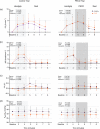Cardiorespiratory responses to muscle metaboreflex activation in fibrosing interstitial lung disease
- PMID: 35298060
- PMCID: PMC9314965
- DOI: 10.1113/EP090252
Cardiorespiratory responses to muscle metaboreflex activation in fibrosing interstitial lung disease
Abstract
New findings: What is the central question of this study? We determined whether sensory feedback from metabolically sensitive skeletal muscle afferents (metaboreflex) causes a greater ventilatory response and higher dyspnoea ratings in fibrosing interstitial lung disease (FILD). What is the main finding and its importance? Ventilatory responses and dyspnoea ratings during handgrip exercise and metaboreflex isolation were not different in FILD and control groups. Blood pressure and heart rate responses to handgrip were attenuated in FILD but not different to controls during metaboreflex isolation. These findings suggest that the muscle metaboreflex contribution to the respiratory response to exercise is not altered in FILD.
Abstract: Exercise limitation and dyspnoea are hallmarks of fibrosing interstitial lung disease (FILD); however, the physiological mechanisms are poorly understood. In other respiratory diseases, there is evidence that an augmented muscle metaboreflex may be implicated. We hypothesized that metaboreflex activation in FILD would result in elevated ventilation and dyspnoea ratings compared to healthy controls, due to augmented muscle metaboreflex. Sixteen FILD patients (three women, 69±14 years; mean±SD) and 16 age-matched controls (four women, 67±7 years) were recruited. In a randomized cross-over design, participants completed two min of rhythmic handgrip followed by either (i) two min of post-exercise circulatory occlusion (PECO trial) to isolate muscle metaboreflex activation, or (ii) rested for four min (Control trial). Minute ventilation ( ; pneumotachometer), dyspnoea ratings (0-10 Borg scale), mean arterial pressure (MAP; finger photoplethysmography) and heart rate (HR; electrocardiogram) were measured. was higher in the FILD group at baseline and exercise increased similarly in both groups. remained elevated during PECO, but there was no between-group difference in the magnitude of this response (Δ FILD 4.2 ± 2.5 L·min-1 vs. controls 3.6 ± 2.4 L·min-1 , P = 0.596). At the end of PECO, dyspnoea ratings in FILD were similar to controls (1.0 ± 1.3 units vs. 0.5 ± 1.1 units). Exercise increased MAP and HR (P < 0.05) in both groups; however, responses were lower in FILD. Collectively, these findings suggest that there is not an augmented effect of the muscle metaboreflex on breathing and dyspnoea in FILD, but haemodynamic responses to handgrip are reduced relative to controls.
Keywords: dyspnoea; exercise tolerance; group III/IV afferents; interstitial lung disease.
© 2022 The Authors. Experimental Physiology published by John Wiley & Sons Ltd on behalf of The Physiological Society.
Conflict of interest statement
The authors have no conflicts of interest to disclose.
Figures


References
-
- Amann, M. , Blain, G. M. , Proctor, L. T. , Sebranek, J. J. , Pegelow, D. F. , & Dempsey, J. A . (2010). Group III and IV muscle afferents contribute to ventilatory and cardiovascular response to rhythmic exercise in humans. Journal of Applied Physiology, 109, 966–976. 10.1152/japplphysiol.00462.2010 - DOI - PMC - PubMed
-
- Amann, M. , Venturelli, M. , Ives, S. J. , Morgan, D. E. , Gmelch, B. , Witman, M. A. , Groot, H. J. , Wray, D. W. , Stehlik, J. , & Richardson, R. S . (2014). Group III/IV muscle afferents impair limb blood in patients with chronic heart failure. International Journal of Cardiology, 174, 368–375. 10.1016/j.ijcard.2014.04.157 - DOI - PMC - PubMed
Publication types
MeSH terms
Associated data
LinkOut - more resources
Full Text Sources
Medical
Miscellaneous

